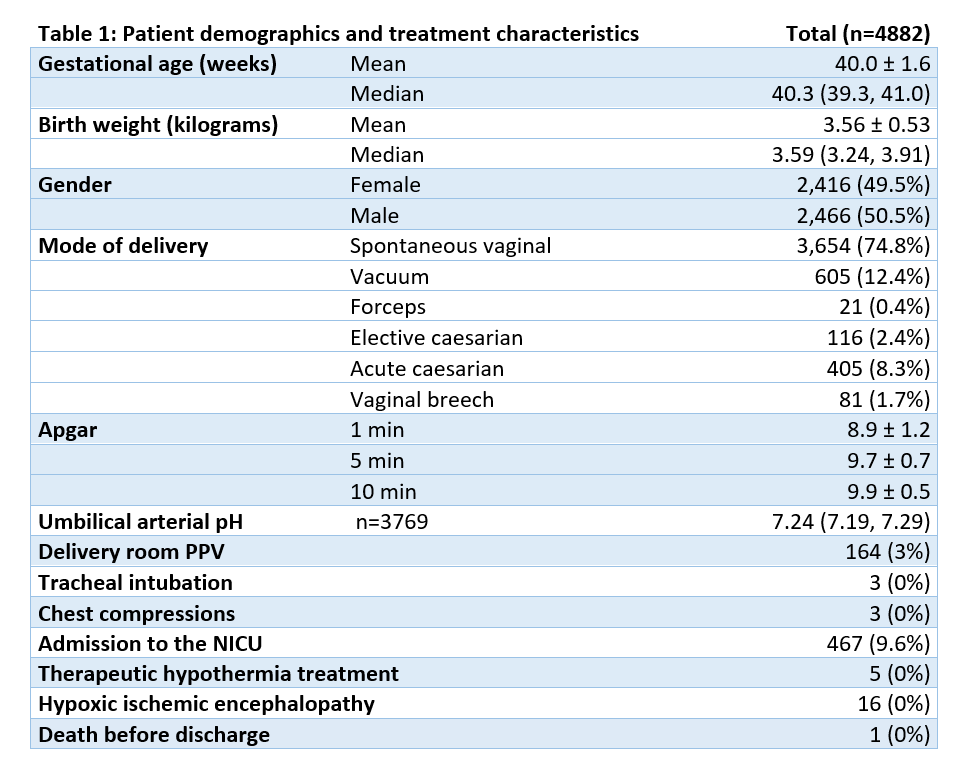Back
Background: Prevalence of bradycardia among an unselected cohort of newborns in the first critical minute after birth is unknown. According to guidelines, heart rate (HR) should be assessed, and positive pressure ventilation (PPV) initiated within one minute if the newborn is not breathing or has HR < 100 beats per minute (bpm). The dry-electrode electrocardiogram device NeoBeat allows for rapid and continuous measurement of newborn HR.
Objective: The objectives were to study i) the HR distribution, ii) prevalence of HR < 100 and < 60 bpm in the first minute after birth, and iii) association between HR < 100 bpm and PPV.
Design/Methods: Observational population–based study conducted at Stavanger University Hospital, Norway, 6 June 2019 – 8 December 2021. Parental consent was obtained in pregnancy. Newborns born at ≥28 weeks’ gestation had HR captured immediately after birth and continuously every second during the first minutes of life. Time of birth was registered using an iPad tablet. Provision of PPV was captured by ventilation monitors and video.
Results: In total 4882 newborns were included; of these 164 (3.4%) received PPV. Newborn characteristics are shown in Table 1.
First measured HR had wide distribution (Figure 1). The prevalences of bradycardia with first measured HR < 100 and < 60 bpm, recorded median (quartiles) 16 (11, 28) seconds after birth, were 16.4% and 0.6%, respectively. At 60 seconds, the prevalences of HR < 100 and < 60 bpm were 3.7% and 0.07%. In total 24.3% of newborns had some HR < 100 bpm within the first 60 seconds after birth.
Among newborns with some bradycardia registered within the first 60 seconds (n=1186), first measured HR < 100 bpm (n=799), and HR at 60 seconds < 100 bpm (n=162), 5.4%, 6.6% and 17.9% ended up receiving PPV, respectively.
In the 164 newborns receiving PPV, the median first measured HR was 117 (88, 153) bpm, with 32.2% and 6.7% having a first HR < 100 and < 60 bpm.
Conclusion(s): Almost 1 out of 4 newborns had some HR < 100 bpm during the first minute after birth. Due to a rapid increase in HR in most cases, only 3.7% had HR < 100 bpm at 60 seconds, of which less than 20% received PPV. Two-thirds of newborns that received PPV, had first measured HR >100 bpm. The findings challenge current guidelines of using a HR threshold of 100 bpm in the first minute for starting PPV.

.png)
Neonatal/Infant Resuscitation
Neonatal/Infant Resuscitation 4
703 - Prevalence of bradycardia in 4882 newborns in the first minute of life, a population-based study
Monday, May 1, 2023
9:30 AM – 11:30 AM ET
Poster Number: 703
Publication Number: 703.445
Publication Number: 703.445
Siren I. Rettedal, Stavanger University Hospital, Stavanger, Rogaland, Norway; Amalie Kibsgaard, Stavanger University Hospital, Stavanger, Rogaland, Norway; Jan Terje Kvaløy, University of Stavanger, Stavanger, Rogaland, Norway; Joar Eilevstjønn, Laerdal Medical, Sandnes, Rogaland, Norway; Hege Ersdal, Stavanger University Hospital, Stavanger, Rogaland, Norway

Siren I. Rettedal, Professor (she/her/hers)
neonatologist
Stavanger University Hospital
Stavanger, Rogaland, Norway
Presenting Author(s)
Background: Prevalence of bradycardia among an unselected cohort of newborns in the first critical minute after birth is unknown. According to guidelines, heart rate (HR) should be assessed, and positive pressure ventilation (PPV) initiated within one minute if the newborn is not breathing or has HR < 100 beats per minute (bpm). The dry-electrode electrocardiogram device NeoBeat allows for rapid and continuous measurement of newborn HR.
Objective: The objectives were to study i) the HR distribution, ii) prevalence of HR < 100 and < 60 bpm in the first minute after birth, and iii) association between HR < 100 bpm and PPV.
Design/Methods: Observational population–based study conducted at Stavanger University Hospital, Norway, 6 June 2019 – 8 December 2021. Parental consent was obtained in pregnancy. Newborns born at ≥28 weeks’ gestation had HR captured immediately after birth and continuously every second during the first minutes of life. Time of birth was registered using an iPad tablet. Provision of PPV was captured by ventilation monitors and video.
Results: In total 4882 newborns were included; of these 164 (3.4%) received PPV. Newborn characteristics are shown in Table 1.
First measured HR had wide distribution (Figure 1). The prevalences of bradycardia with first measured HR < 100 and < 60 bpm, recorded median (quartiles) 16 (11, 28) seconds after birth, were 16.4% and 0.6%, respectively. At 60 seconds, the prevalences of HR < 100 and < 60 bpm were 3.7% and 0.07%. In total 24.3% of newborns had some HR < 100 bpm within the first 60 seconds after birth.
Among newborns with some bradycardia registered within the first 60 seconds (n=1186), first measured HR < 100 bpm (n=799), and HR at 60 seconds < 100 bpm (n=162), 5.4%, 6.6% and 17.9% ended up receiving PPV, respectively.
In the 164 newborns receiving PPV, the median first measured HR was 117 (88, 153) bpm, with 32.2% and 6.7% having a first HR < 100 and < 60 bpm.
Conclusion(s): Almost 1 out of 4 newborns had some HR < 100 bpm during the first minute after birth. Due to a rapid increase in HR in most cases, only 3.7% had HR < 100 bpm at 60 seconds, of which less than 20% received PPV. Two-thirds of newborns that received PPV, had first measured HR >100 bpm. The findings challenge current guidelines of using a HR threshold of 100 bpm in the first minute for starting PPV.

.png)
